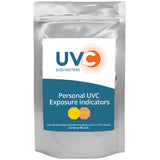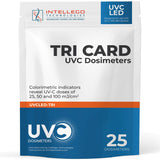That UVC LED You Bought on Amazon Probably Doesn't Work
Posted by Nick on for ProLampSales

Over the last couple months, interest in and purchases of ultraviolet germicidal irradiation lights (bulbs and fixtures) has skyrocketed. And with the growing interest in using UVC light to kill germs has been a corresponding rise in low-cost solutions on marketplaces like Amazon and eBay.
Can you really get a 500W UVC LED corn cob bulb that will kill all the germs in your room, that you can just screw into a ceiling fan or table lamp?
Sounds too good to be true...
It's Too Good to Be True
In this article on Hackaday, a buyer ordered one of these LED corn cob "UVC germicidal" bulbs. Voja Antonic, the author, describes the actual product he received.
[P]roper UV-C LED lenses like the one shown here are made of quartz glass. Compare that to the image at the top of the article of the bulb I received that has a soft plastic lens, which is possibly opaque and degradable in the far UV range. The most important clue that something was wrong was the price. It’s hard to imagine that a UV-C LED lamp with the 253.7nm wavelength, made of more than 200 LEDs and in such a robust metal case, can cost only $62.99.
This one quote illustrates numerous problems about the UV germicidal bulbs being sold on some websites right now.
Lower Cost, Higher Output?
Many of the UVC bulbs sold online like this seem to offer a lower cost than a mercury bulb and fixture, and at a significantly higher wattage. While LEDs can put out more light and use less energy, the trade-off is usually a higher cost.
Especially with more technical lighting products like UVC, LED solutions should cost significantly more than standard mercury lamps.
The bottom line is that these "UVC LED bulbs" are lower cost because they are regular LEDs, not UVC.
UVC, UVA, It's NOT All the Same
Interestingly, this particular product was advertised as a germicidal UVC bulb. But when the buyer got the datasheet from the seller, the bulb was a simple blacklight UVA bulb.
UVA is not in the germicidal part of the ultraviolet spectrum, and any buyers of this (or a similarly mislabeled) product would not be disinfecting anything (or at least not in any timely manner).
Why Not Buy an Ineffective Bulb
We've had numerous inquiries from people asking why they shouldn't just buy whatever is cheapest on Amazon or eBay for an ultraviolet bulb.
This is why.
This is one example of a wide range of similarly-priced "UVC" bulbs. It won't effectively kill germs inside your bedroom, on your countertop, or in the air of your living room.
But it's labeled just like any other UVC bulb. In fact, it's cheaper than many CFL/fluorescent UVC bulbs. Because it's a fake.
Homeowners Buying Placebos
For homeowners who buy a fake UVC bulb, they may get some placebo effect, but they could also contract the coronavirus if it's survived on the surface of the Chinese-made non-UVC LED bulb.
But in most cases, the best that will happen is you get an overpriced-but-cool blacklight LED. The worst is the bulb won't work at all. It won't kill germs in any timely fashion, though.
Doctors & Dentists Increasing Risk of Infection
Surprisingly, we've had a few doctors, dentists, and other medical professionals call and ask us if they can use these bulbs in their offices to disinfect surfaces, PPE, and medical equipment.
Because these fake UVC bulbs won't even disinfect themselves, using them instead of a real UVC air/surface fixture for killing germs could increase the risk of infection and cross-contamination.
Not having an ultraviolet germicidal solution isn't a crime when other sterilization options are used. However, relying on a fake UVC bulb -- that was $60 and doesn't do what it's advertised for and was too good to be true in the first place -- could increase the risk of spreading bacteria and viruses.
Mini Buyers Guide for UVC Bulbs
We aren't saying that every $30-$80 LED UVC bulb is a fake. Maybe some do what they say they will. But there are too many sellers who are advertising UVA non-germicidal blacklights as germicidal UVC bulbs.
If you are going to buy one of these LED UVC bulbs from a brand you've never heard of, which doesn't have a website, on a marketplace site like Amazon or eBay, follow these two guidelines.
1. Ask for the Datasheet
The bulb should have a specification/data sheet that shows the measured wavelength of the bulb. This may not be attached on the Amazon or eBay listing, but the manufacturer should have it. And if they can't provide it, run far away.
If the specification sheet shows the bulb's wavelength does not peak around 254nm or in that range, it's not UVC. Buy it as a cool blacklight, but don't rely on it to purify air or surfaces.
And if you suspect the wavelength chart is wrong, don't buy it. And if you buy it even if you suspect the datasheet is lying to you, follow the next recommendation.
2. Use UVC LED Dosimeters
To address both new LED UVC device manufacturers and fight fraud, Intellego Technologies has developed a dosimeter specifically for LED devices.
Because many LED UVC products emit a wavelength between 260-280nm, existing dosimeters that are designed for 254nm light sources won't work as effectively.
Dosimeters for testing and verifiying UVC equipment is a very inexpensive but important investment. And if the dosimeter does not change color after exposure to the light, it is almost certainly a fake or faulty. In either case, it is not providing germicidal irradiation.
3. Buy a UVC Light Meter
One way to test the bulb is to purchase a UVC light meter that measures the intensity of the bulb in the 254nm wavelength. This is one of the only ways to ensure the bulb itself is outputting UVC rays.
Yes, UVC light meters are sometimes much more expensive than the bulbs or fixtures. However, they can mean the difference between disinfection and placebo, which is a matter of life or death in some situations.
And in any case, if the UVC bulb/fixture (LED or fluorescent) seems too good to be true, it probably is.
- Posted in LED, Ultraviolet Light
Featured Products (View All)
0 Comments




